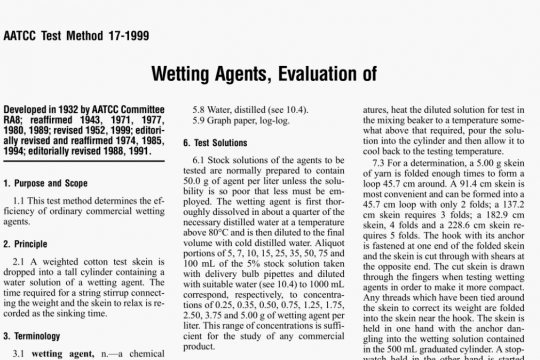AATCC 107 pdf free download
AATCC 107 pdf free download.Colorfastness to Water.
3. Terminology
3.1 colorfastness, n.—the resistance of a material to change in any of its color characteristics, to transfer of its colorant(s) to adjacent materials or both, as a result of the exposure of the material to any environment that might be encountered during the processing, testing. storage or use of the material.
4. Safety Precautions
NOTE: These safety precautions are for information purposes only. The precautions are ancillary to the testing procedures and are not intended to be all inclusive. It is the user’s responsibility to use safe and proper techniques in handling materials in this test method. Manufacturers MUST be consulted for specific details such as material safety data sheets and other manufacturer’s recommendations. All OSHA standards and rules must also be consulted and followed.
4. 1 Good laboratory practices should be followed. Wear safety glasses in all laboratory areas.
4.2 Manufacturer’s safety recommendations should be followed when operating laboratory testing equipment.
4.3 Observe paddcr safety. Ensure adequate guard at the nip point. Nornal safeguards on pad should not be removed.
5. Apparatus and Materials
5.1 AATCC Perspiration Tester. Perspirometer or equivalent device (plastic or glass plates are available with the equipment) (see 12.1 and 12.2).
5.2 Drying oven—convection.
5.3 Multifiber test fabric No. I or No.
10 (see 12.1).
5.4 AATCC Chromatic Transference Scale (see 12.1).
5.5 AATCC Gray Scale for Color Change and Gray Scale for Staining (see
12.1).
5.6 Wringer (see 12.3).
6. Test Solution
6.1 Freshly boiled distilled water or deionized water from an ion-exchange device.
7. Test Specimens
7.1 Colored specimens 60 x 60 mm ± 2 mm (2.25 x 2.25 in.) backed with multi- fiber test fabric.
8. Procedure
8.1 Immerse the test specimen in the test solution at room temperature with occasional agitation to ensure thorough wetting out (approximately 15 mm generally required for average fabrics) (see 12.4).
8.2 Remove the test specimen from the test solution and only pass between squeeze rolls (wringer) to remove excess liquor when the wet weight of the test specimen is more than 3 times its dry weight. Whenever possible, the wet weight should be 2.5-3.0 times the dry weight.
8.3 Place the test specimen between glass or plastic plates and insert in the specimen unit of the perspiration tester. Adjust the perspiration tester to produce a pressure of 4.5 kg (10.0 Ib) on the test specimen (see 12.2).
8.4 Heat the loaded specimen unit in an oven at 38 ± 1°C (100 ± 2°F) for 18 h. Remove specimen from unit and cornplctc drying by hanging in air at room temperature. Do not press dry.
12. Notes
12.1 For procurement see listings tinder
Special Equipment and Materials Used in
AATC’C Test Methods in the AATCC TEc’HNICAL MANUAL.
12.2 AATCC Perspiration Tester: Put all 21 glass or plastic plates into the unit regardless of the number of specimens. After the final glass or plastic plate is put in position on top, set the dual plates with compensating springs in position. Place the 3.6 kg (8.0 Ib) weight on top making a total of 4.5 kg (10.0 Ib) under the pressure plate. Lock the pressure plate in position by turning the thumb-screws. Remove the weight. Place the unit in the oven on its side, so that the plates and the specimens are vertical.
Perspirometer: The plates are held in a vertical position between an indicating scale with a lixed metal plate at one end and an adjustable metal plate at the other end. By means of adjusting screws, the movable plate may be made to exert increasing pressure against the test specimens. When the desired pressure of 4.5 kg (10.0 Ib) is indicated on the scale, lock the specimen in it by a set screw. The speci- men unit can now be removed from the seC- tion applying the pressure. Another specimen unit can be added to the pressure section and the loading procedure repeated.AATCC 107 pdf download.




